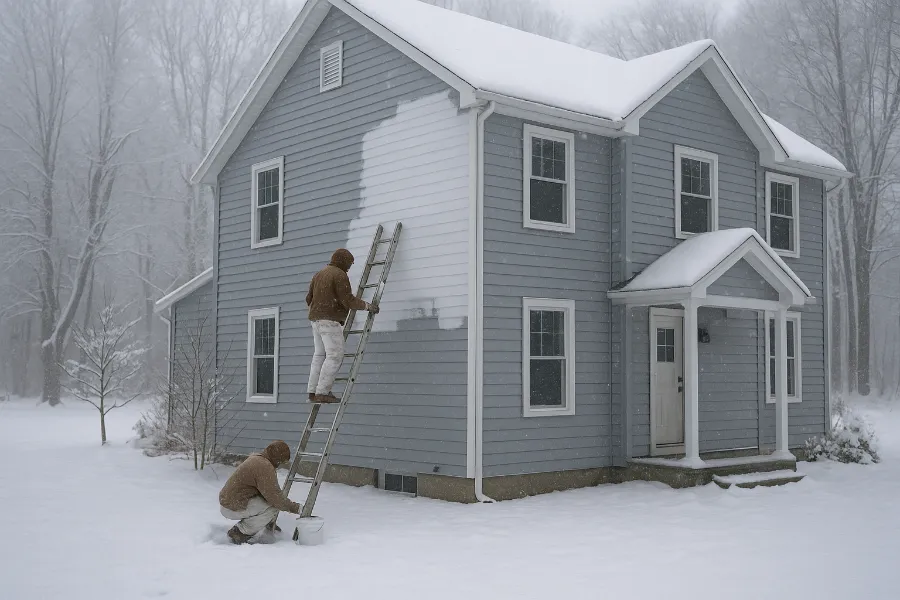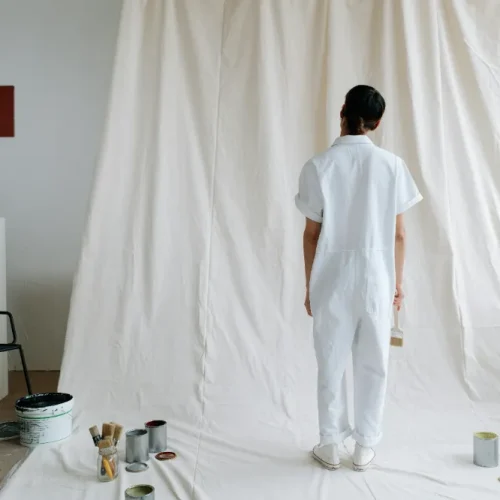
There’s a particular kind of stubbornness that kicks in when you’re ready to paint. Once the color is chosen and the supplies are laid out, the urge to “just get it done” takes over. I’ve been there standing in a chilly garage or an unheated room, covered in optimism and denial, telling myself, “It’s probably fine. Paint is paint.” But every time I’ve painted in cold temperatures, I’ve learned that temperature quietly controls everything. Paint isn’t just colored liquid in a can it’s chemistry. And that chemistry responds dramatically to cold. From drying time to bonding strength to long-term durability, the cold disrupts the entire process in ways that don’t always show up immediately. Some consequences don’t appear until weeks or even months later. Let me walk you through what actually happens when you paint in cold weather and why it matters more than most people realize.
Cold Air Slows Drying in Ways You Don’t Notice Until It’s Too Late
One of the first signs you’re painting in temperatures that are too low is that the paint feels like it’s taking forever to dry. In comfortable temperatures, latex paint typically dries within an hour. But the moment the air turns cold, evaporation slows dramatically. The surface may feel dry what some people call a “false dry” while underneath, the layers remain soft and sticky. I’ve made the mistake of applying a second coat on top of a seemingly dry first coat, only to find out later that the bottom layer was still wet. This delayed drying throws everything off, because the top layer begins to harden while the bottom layer remains gum-like. It’s basically a recipe for peeling or wrinkling later.
Cold Temperatures Interfere With Paint Curing, Leaving the Finish Weak and Soft
There’s drying, and then there’s curing and yes, they’re different. Drying is about moisture leaving the paint. Curing is about the paint chemically hardening into a durable shell. Cold temperatures interfere mainly with curing, and this is where the trouble really begins. The chemical process responsible for creating a strong paint film slows down dramatically. In latex paint, the particles are supposed to merge through a process called coalescence, which you can read more about here.
When temperatures drop too low, these particles struggle to merge properly. I’ve had trim that stayed soft for weeks because the room wasn’t warm enough. Every touch left a mark, and cleaning the surface was impossible without causing damage. Once curing is compromised, there’s no repairing it later. The paint never reaches its intended durability.
Paint Loses Its Grip When the Surface Is Too Cold
Adhesion is invisible until it fails. When paint is applied to a cold surface even if the air feels warm enough the paint can’t bond properly. I’ve had exterior walls look great for months and then suddenly start to peel when warmer temperatures arrived. Cold materials tend to attract condensation, even in tiny, invisible amounts. Painting over a surface that’s even slightly damp guarantees adhesion problems. By the time you notice it, the damage is already done.
Latex Paint Can Freeze or Turn Gritty, Even After Thawing

Latex paint is water-based, which means it can freeze. I’ve opened cans after a cold winter only to find a grainy, separated mess. Even if the can didn’t fully freeze, cold exposure damages the formula. Once the chemical structure is compromised, no amount of stirring will bring it back. It spreads unevenly, dries unpredictably, and creates a gritty texture. Some paints are labeled as “freeze–thaw stable,” but even those have limits.
Cold Weather Makes Paint Thicker, and That Changes Everything About How It Applies
Whenever I’ve tried painting in cold temperatures, the first thing I noticed was how thick the paint felt. Rolling becomes harder, brushing feels sticky, and spraying becomes a guessing game. Thickened paint doesn’t self-level the natural process that smooths out brush and roller marks. Instead, it dries with visible strokes, lines, and uneven patches. Even premium paint struggles because cold interrupts its natural flow.
Patchy Color and Uneven Shine Are Common in Cold-Weather Painting
One unexpected effect of cold painting is uneven sheen. Satin, eggshell, and semi-gloss finishes are especially sensitive. When cold slows the drying process, different parts of the wall dry at different rates. Some areas become shinier, others flatter. I once painted a hallway in winter and couldn’t figure out why no amount of touch-up fixed the uneven sheen. It wasn’t the paint it was the temperature.
Condensation Quietly Ruins the Paint Before You Even Know It’s There
Condensation is one of the sneakiest problems. Cold surfaces naturally attract moisture, and that moisture might be completely invisible. Indoors, it shows up in basements, bathrooms, laundry rooms, and garages. Outdoors, it settles overnight as the temperature drops. If you paint over condensation, the paint sits on top of the moisture instead of bonding with the wall. The next day you may see streaking, sagging, or milky areas. Sometimes you see nothing until the paint starts peeling weeks later.
Oil-Based Paint Thickens in the Cold and Loses Its Smoothness
Oil-based paint behaves differently from latex paint, but cold still disrupts it. The oils get thicker, almost syrupy. It becomes harder to brush evenly, and the paint refuses to level out. I’ve seen oil-painted doors dry with ridges, waves, and uneven gloss because the cold slowed everything down. Even though oil-based paint tolerates cold better than latex, it still needs a proper temperature range to cure fully.
Exterior Paint Is Especially Vulnerable to Cracking After Cold Application
If you’ve ever wondered why some exterior paint cracks prematurely, cold-weather application is often the hidden cause. The paint film becomes weak or brittle when it never fully cures. As temperatures change throughout the seasons, the surface underneath expands and contracts but the weakened paint can’t move with it. Cracks start small and then spread. I’ve seen perfectly fine paint jobs fail in spring because the paint had been applied during a cold spell months before.
Painting Tools Perform Poorly When the Paint Is Too Cold
Brushes stiffen, roller covers stop absorbing properly, and sprayers sputter or clog. Even if the paint could theoretically handle the temperature, the tools might not. I’ve had rollers leave strange patchy textures because the paint was too thick to saturate them evenly. Everything becomes harder in the cold.
Indoor Cold Causes Just as Many Problems as Outdoor Cold
It’s easy to assume indoor painting is safe during winter, but unheated rooms behave exactly like exterior sites. A room can feel cool but still have wall temperatures far below what paint needs. When I painted a basement in winter, the walls took days to dry and ended up collecting dust, debris, and lint before the paint ever hardened. The final finish felt gritty, and the only way to fix it was to redo the entire project in warmer weather.
Manufacturers List Temperature Minimums for a Reason
Most latex paints want temperatures of at least 50°F, and oil-based paints usually want 45°F or higher. But here’s the part people miss: the surface temperature matters more than the air. A wall can feel chilly even in a warm room, especially near windows or exterior corners. That cold surface slows the chemical reactions that paint relies on. It’s a good reminder that what feels warm to us may not be warm enough for a proper paint job.
Cold-Weather Paint Helps, but It Isn’t Magic
There are specialized “low-temperature” paints designed to work in conditions as low as 35°F. They’re helpful, and I’ve used them successfully, but they can’t fix condensation, freezing nights, or surfaces that are simply too cold to touch. Cold-weather paint extends the range not the rules of chemistry.
Cold-Weather Painting Usually Costs More in the Long Run
The biggest irony of cold-weather painting is that trying to “get it done” faster usually results in more work later. You end up scraping peeling sections, sanding ruined areas, and repainting entire walls. I’ve learned that patience waiting for a good temperature window almost always saves time and money.

Final Thoughts: Temperature Isn’t Optional When It Comes to Painting
Painting in cold temperatures seems harmless, but the consequences unfold slowly and quietly. Drying slows down, curing weakens, adhesion fails, and the finish loses the smoothness and durability you expect. Cold weather doesn’t just inconvenience the project it changes the outcome. I’ve learned that respecting the temperature recommendations on the paint can is one of the simplest ways to guarantee a paint job looks good and lasts. When it comes to painting, the weather isn’t just background noise it’s part of the project.
FAQs
Most latex paints require at least 50°F, while oil-based paints need around 45°F. Some cold-weather paints can go as low as 35°F but still have limitations.
Cold temperatures slow drying, weaken curing, reduce adhesion, cause uneven sheen, and may lead to peeling, cracking, or tacky surfaces.
Cold air slows the evaporation of water or solvents, which delays drying and keeps lower layers soft even when the surface feels dry.
If latex paint freezes and becomes grainy or lumpy, it’s usually ruined. Even if it looks okay, the formula may be chemically damaged.
Yes. Cold conditions can cause patchy color, inconsistent sheen, roller marks, brush strokes, and an overall uneven texture.
Absolutely. Condensation prevents proper adhesion and can lead to streaking, peeling, or a milky finish, especially overnight.
No. Even indoor surfaces must be within recommended temperature ranges. Cold walls can cause slow drying and adhesion problems.
Oil-based paint tolerates cold slightly better, but it still thickens, dries unevenly, and fails to cure properly when temperatures drop too low.
Use cold-weather paint, heat the room, warm the paint indoors first, keep temperatures stable, and ensure surfaces aren’t cold to the touch.
Because cold temperatures prevented proper bonding and curing. The failure might not appear until warmer weather triggers expansion and contraction.










